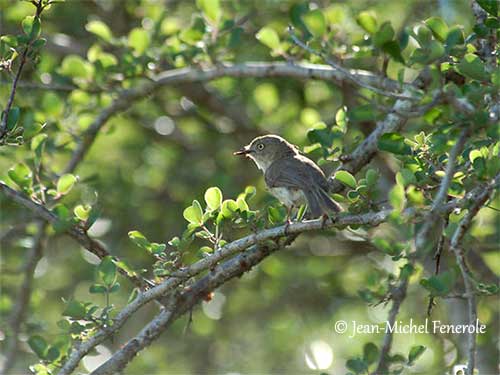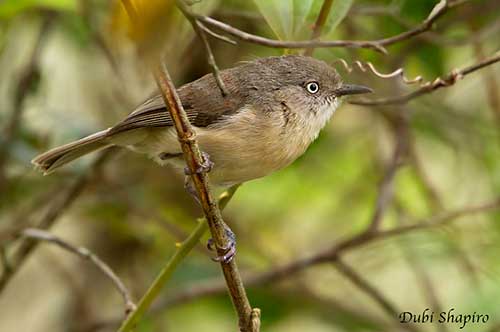REPRODUCTION OF THIS SPECIES:
The breeding season apparently occurs between July and March with geographical variations throughout the island.
The Common Newtonia builds a deep cup-shaped structure hidden among the vegetation, between 1,75 and 10 metres above the ground. This small nest is made with bits of plants and grass interwoven with small twigs. The materials are held together with spider webs. The nest is lined inside with dark grass stems. It is usually attached to the supporting branches with spider webs.
The female lays 3 pale yellowish eggs with reddish markings. Fledged young can be seen in December/January in rainforest.
PROTECTION / THREATS / STATUS:
The Common Newtonia is common and widespread in suitable forested habitats, and is one of the commonest species in these areas.
The species is not globally threatened, and currently evaluated as Least Concern.
Fr: Newtonie commune
Ang: Common Newtonia
All: Rostbauchnewtonie
Esp: Newtonia Común
Ita: Newtonia comune
Nd: Roodbuiknewtonia
Sd: grå newtonia
Mal: Katekateky, Tretretre
Photographers:
John Anderson
John Anderson Photo Galleries
Jean Michel Fenerole
Photos d’Oiseaux du monde
Patrick Ingremeau
TAMANDUA
Dubi Shapiro
Dubi Shapiro Photo Galleries & Dubi Shapiro's Pictures on IBC
Text by Nicole Bouglouan
Sources:
HANDBOOK OF THE BIRDS OF THE WORLD Vol 11 by Josep del Hoyo, Andrew Elliott and David Christie - Lynx Edicions - ISBN: 849655306X
Birds of Madagascar and the Indian Ocean Islands Par Roger Safford, Adrian Skerrett, Frank Hawkins – ISBN: 1472924118, 9781472924117- Editeur: Bloomsbury Publishing, 2015
The Birds of Africa: Volume VIII: The Malagasy Region: Madagascar, Seychelles, Comoros, Mascarenes - Par Roger Safford, Frank Hawkins – ISBN: 1408190494, 9781408190494- Editeur: A&C Black, 2013
Birds of the Indian Ocean Islands Par Ian Sinclair, Olivier Langrand - ISBN: 1868729567, 9781868729562- Editeur: Struik, 2003
Wildlife of Madagascar par Ken Behrens,Keith Barnes - ISBN: 140088067X, 9781400880676 – Editeur: Princeton University Press, 2016
Creagus – Bird Families of the World – Vangas - Vanginae
THE VANGAS OF MADAGASCAR by Nick Garbutt
Common Newtonia
Newtonia brunneicauda
Passeriformes Order – Vangidae Family
INTRODUCTION:
The Common Newtonia is endemic to Madagascar and common in all native forested habitats, including disturbed areas and secondary growth. It feeds on small invertebrates by gleaning from leaves and small branches.
This species is now in the family Vangidae, but it was formerly in the family Sylviidae that includes the Old World warblers.
The genus Newtonia is endemic to Madagascar, and following some genetic analyses, it is suggested that Newtonia is a product of the same Malagasy radiation from which the Vangidae (vangas) originated. Voice and nest structure also suggest this origin.
The Common Newtonia is one of the commonest forest birds, but limited to native forest. The species is not currently threatened.
SUBSPECIES AND RANGE:
The Common Newtonia has two subspecies.
N.b. brunneicauda (described above) is found in forested parts of Madagascar, including forest relicts in C highlands.
N.b. monticola occurs in Ankaratra Mts in C Madagascar. This race is larger than nominate, with darker greyish olive-brown upperparts and brighter brownish-buff underparts.
HABITAT:
The Common Newtonia is common within and close to the primary forest habitats, including in the southern spiny forest, and isolated forest patches on C highlands and E lowlands. The species is present from sea-level up to 2,300 metres of elevation at least.
CALLS AND SONGS: SOUNDS BY XENO-CANTO
The Common Newtonia gives harsh “kchh kchh kchh…” or “bzz bzz bzz…”
The powerful song given from perch is a rapid rattling “kitrikitrikitrikitrik” lasting 2-3 seconds. This song may include alternating “tik-a” notes or similar “kiapakiapakiapakiap”. It often starts with a short “chrrr”. Several birds often sing in chorus.
The Malagasy names of this species, Katekateky and Tretretre, are derived from the song.

BEHAVIOUR IN THE WILD:
The Common Newtonia feeds on small invertebrates including various insects such as Coleopterans, Hemipterans, Dipterans, Hymenopterans and Lepidopterans. It also catches spiders.
It is often seen in flowers, probably attracted by insects rather than nectar.
It forages at all levels in the forest, and catches prey by gleaning from leaves and small branches. It can be seen alone or in pairs, and also in small mixed-species groups in which it is often a dominant member. It is always very active. It gives loud alarm calls at intruders, including mammals.
Some displays have been observed during the breeding season, but there is little information on this behaviour.
From an observation, a display involves two adults in front of each other, flicking their wings while the tail is spread downwards. Both birds are silent.
The Common Newtonia is probably sedentary on the island. It has short, rounded wings, and only performs short-distance flights.

DESCRIPTION OF THE BIRD:
Biometrics:
Length: 12 cm
Weight: 7-14 g
The Common Newtonia has greyish-brown upperparts. On the upperwing, the coverts are greyish-brown, but the flight-feathers are slightly darker with buffy edges. The tail is greyish-brown but the outer rectrices are slightly paler.
The underparts are warm buff, but chin, throat and belly are whiter. The undertail-coverts are off-white.
On the head, the crown is greyish-brown, but head and neck sides are paler. Chin and throat are whitish.
The bill is black. The eyes are pale dull yellow to golden-yellow. Legs and feet are pale pinkish-brown to greyish-brown.
Male and female are similar.
The juvenile is browner on the upperparts with some rufous-brown tips to greater coverts, and pale orange-brown tinge on tertials. The eyes are darker than in adults, mostly brownish-grey.
